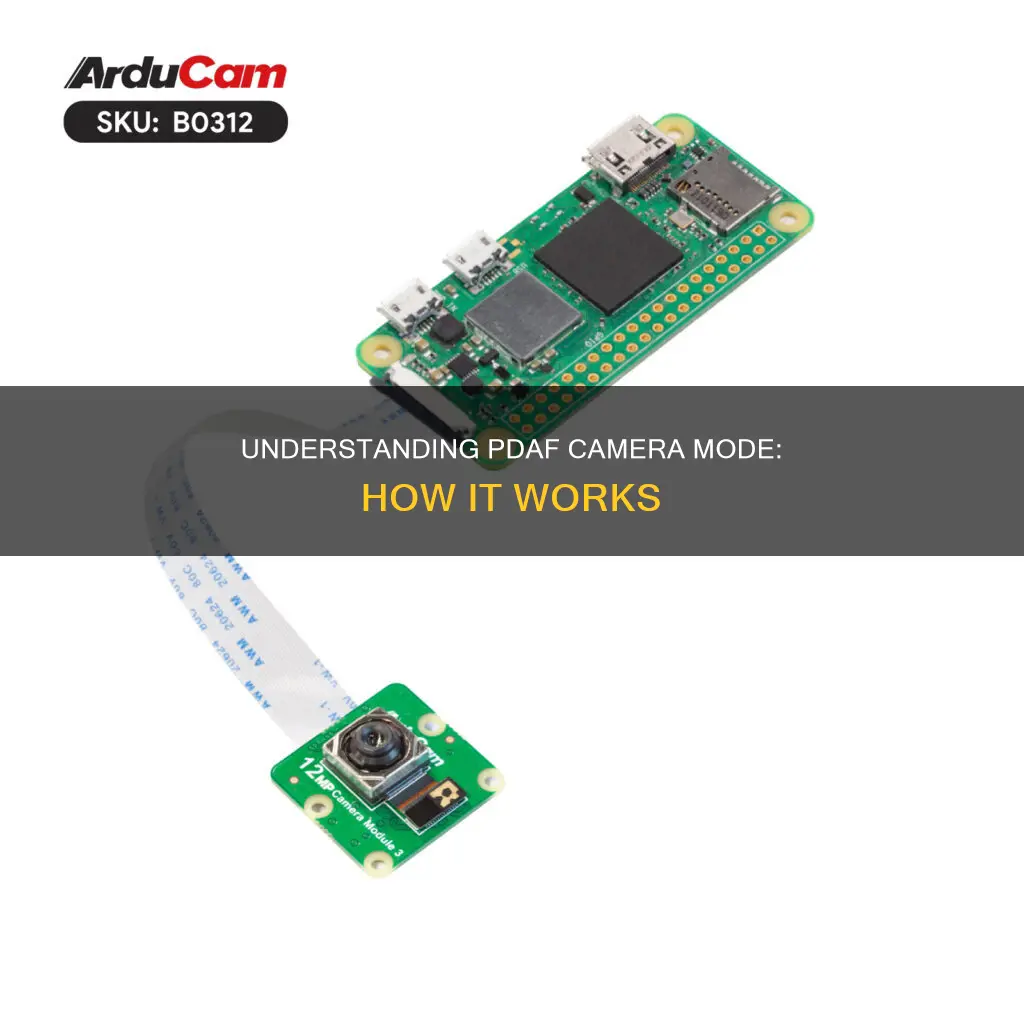
Phase Detection Autofocus (PDAF) is an autofocus technology that is faster and more accurate than conventional contrast detection autofocus. PDAF works by splitting the image the camera sees into two separate images, using prisms in a DSLR or on-sensor for mirrorless cameras. The camera can tell if an image is in focus by checking if the two images are lined up or in phase with each other. If the images are out of phase, the camera uses this information to adjust the lens to put the image in focus. This process happens in milliseconds, making PDAF ideal for sports and wildlife photography, as well as for capturing moving objects.
| Characteristics | Values |
|---|---|
| Full Form | Phase Detection Autofocus |
| Use | Faster and more accurate focusing of the camera lens |
| Working | Splits the image into two, checks for a phase mismatch and adjusts the lens accordingly |
| Compatibility | High-end cameras and smartphones |
| Advantages | Faster, more precise, suitable for sports and wildlife photography, good for abrupt shifts in focus |
| Disadvantages | Can be problematic in low-light situations |
What You'll Learn

PDAF vs CDAF
Phase detection autofocus (PDAF) and contrast autofocus (CDAF) are two different autofocus systems used in cameras.
CDAF focuses directly on the sensor and uses a distinct line in the image by moving the lens until that line obtains the highest contrast, which coincides with the sharpest focus. It works best with lenses designed to move with these focus motions and is found on P&S cameras and micro 4/3 cameras like the OM-D E-M5 and E-P5.
PDAF, on the other hand, uses a sensor placed in the light path created by the mirror. It works with any DSLR or single-lens reflex camera and uses two sensor points to detect the phase difference in the light path to find the exact distance. It then moves the lens to the correct focus point. PDAF is currently the fastest method of focusing and is found on top DSLRs from all brands.
Some key differences between the two systems are worth noting. For example, PDAF typically uses only part of the light from a lens, while CDAF tends to be less accurate than PDAF. Additionally, PDAF focuses with the lens wide open and then stops down to the set f-number when the photo is taken, while CDAF may focus with the lens at the same f-number used to take the photo, depending on the camera model.
In terms of performance, PDAF is generally faster and more accurate than CDAF, especially in low-light conditions or when photographing fast-moving subjects. However, CDAF can be more precise in certain situations, such as when using lenses designed for its focus motions. Ultimately, both systems have their strengths and limitations, and the ideal choice depends on the specific camera setup and the photographer's requirements.
Samsung S7 Edge: Exploring the Macro Camera Mode
You may want to see also

How does PDAF work?
Phase Detection Autofocus (PDAF) is a technology that allows cameras to focus quickly and accurately. It works by splitting the image the camera sees into two copies or separate images, with each copy receiving light from a different part or side of the lens. When the image is in focus, the light from both sides converges on a single point on the camera sensor. If the image is out of focus, the two copies will be offset, and the camera can use this information to calculate how far the lens needs to move to bring the image into focus. This is done by measuring the phase difference between the two images.
In DSLR cameras, PDAF is achieved using a partial mirror that diverts some of the incoming light to a dedicated array of PDAF sensors. Smartphone cameras, on the other hand, use "focus pixels" built into the image sensor. These focus pixels are pairs of pixels that are partially masked so that each pair receives light from opposite parts or sides of the lens. If the image is in focus, both pixels in a pair will receive the same amount of light. If they receive different amounts of light, the camera can use this information to quickly adjust the lens and bring the image into focus.
PDAF is faster and more accurate than conventional contrast detection autofocus (CDAF). While CDAF works by scanning through its entire range of focal points to find the sharpest focus, PDAF can determine the best focus immediately and adjust the lens directly in one action. This makes PDAF particularly useful for tracking fast-moving subjects and is key for sports and wildlife photography.
PDAF has evolved into more advanced forms, including Dual-Pixel Autofocus, Quad-Pixel Autofocus, and All-Pixel Autofocus, which are found in modern high-end smartphone cameras.
Editing Raw Camera Files: A Step-by-Step Guide
You may want to see also

PDAF in professional cameras
Phase Detection Autofocus (PDAF) is a game-changer for professional cameras, offering lightning-fast and precise autofocus capabilities. This technology is a significant upgrade from the traditional contrast detection autofocus (CDAF) systems, delivering several advantages to photographers.
Firstly, PDAF excels in speed and accuracy. By splitting the camera's view into doppelganger images and checking for a phase mismatch, it can rapidly adjust the lens to achieve perfect focus. This makes it ideal for capturing fast-moving objects or dealing with sudden focus shifts, ensuring sharp images even in dynamic shooting environments.
Secondly, PDAF enables the measurement of distance to objects in each frame. This capability is particularly useful when photographing subjects that are moving or changing direction. By quickly calculating the distance to the subject, PDAF allows for a swift focus adjustment, ensuring the subject remains in focus regardless of their movement.
Additionally, PDAF handles abrupt changes in scene distance with ease. Whether moving the focal point from foreground to background objects or vice versa, PDAF seamlessly adapts, making it perfect for capturing images with variations in depth of field.
PDAF is now a sought-after feature in high-end cameras, as it offers peak autofocus performance. Professional photographers value its ability to deliver stellar image quality and unmatched focus efficacy, making it an intrinsic component of their camera setups.
Moreover, PDAF continues to evolve, with advancements such as Dual Pixel and Quad Pixel autofocus further enhancing its performance. The future of PDAF promises even wider integration and improved capabilities, solidifying its place as a pivotal technology in professional photography.
Mastering Camera Raw Cache: Tips to Control Size
You may want to see also

PDAF in consumer cameras
Phase Detection Autofocus, or PDAF, is an essential feature in consumer cameras. It is a high-speed automatic focus technology that enables faster and more accurate autofocus (AF) than conventional AF. PDAF in consumer cameras uses some of the pixels for imaging on the image sensor as pixels for phase detection. This allows the camera to quickly and accurately focus the lens for each frame, even when there are abrupt changes in scene distance or moving objects.
The way PDAF works is by splitting what the camera sees into doppelganger images and checking for a phase mismatch. This information is then used to regulate lens adjustment and ensure the perfect image capture. In smartphones, certain pixels from the sensor team up for image-forming duties, resulting in faster and more accurate autofocus. Dedicated light sensors in professional cameras and high-end smartphones measure the level of blurriness in an image, allowing for quick and accurate lens focusing.
PDAF offers several advantages over traditional contrast autofocus. It is faster and more precise, making it ideal for sports, wildlife, and other types of photography where rapid focus is crucial. PDAF can also measure the distance to objects in each frame, making it easier to focus on moving or changing direction subjects. Additionally, PDAF can handle instantaneous shifts in focus, such as moving the focal point from front-field to rear objects or vice versa.
While PDAF is a significant improvement over traditional autofocus methods, it does have some drawbacks. The small sensors and pixels in smartphones can make noise an issue in low-light situations, and PDAF may require multiple attempts to achieve perfect focus. To address these limitations, smartphones sometimes use a hybrid approach, combining PDAF with other technologies like laser autofocus.
Dispose of Your Camera's Lithium Battery the Right Way
You may want to see also

PDAF in smartphone cameras
Phase Detection Autofocus, or PDAF, is a common feature in modern smartphone cameras. It is a fast and precise autofocus technology that enables devices to capture crisp and clean images of even the fastest-moving subjects.
PDAF works by creating two copies of an image, then adjusting the lens elements until the two images merge. This is achieved through the use of dedicated phase-detecting photodiodes on the image sensor. These photodiodes are masked so that light from only one side of the lens reaches them, producing left-looking and right-looking pixels. By comparing the phase difference between these two images, the camera can calculate the focus point and determine how to adjust the lens to bring the image into focus. This process is much faster than traditional contrast autofocus, which requires scanning through a range of focal points to find the sharpest focus.
In smartphone cameras, PDAF is implemented using "focus pixels", which are a small percentage of pixels on the main camera sensor grid that have been designated for focusing rather than image capture. These focus pixels come in pairs, with each pixel in the pair receiving light from a different part of the lens. If the two pixels in a pair receive different amounts of light, this provides information about how out-of-focus the image is, allowing the camera to quickly adjust the lens to create a sharp image.
PDAF offers several advantages over other autofocus methods. Firstly, it is significantly faster, with most smartphones now able to focus in less than a second. Secondly, it is more accurate, particularly with moving objects, as it can measure the distance to the subject in every frame. Finally, it can also handle abrupt changes in scene distance, such as when the focus shifts from an object in the back to one in the front.
However, PDAF also has some drawbacks. The small size of smartphone sensors and pixels can make noise an issue in low-light situations, and PDAF may struggle to focus perfectly in such conditions. To address this, smartphones often employ a hybrid approach, combining PDAF with other focusing technologies such as contrast detection autofocus or laser autofocus.
Charging for Cameras: How to Price Your Photography Equipment
You may want to see also
Frequently asked questions
PDAF stands for Phase Detection Autofocus.
PDAF works by splitting the image the camera sees into two separate images. The camera can tell if an image is in focus by checking for a phase mismatch and then uses this information to adjust the lens.
The main advantage of PDAF is speed. It is faster and more accurate than conventional contrast detection autofocus.
PDAF can struggle in low-light situations and with focusing on horizontal lines.
PDAF is found in professional cameras, high-end cameras, consumer cameras, and modern smartphone cameras.







